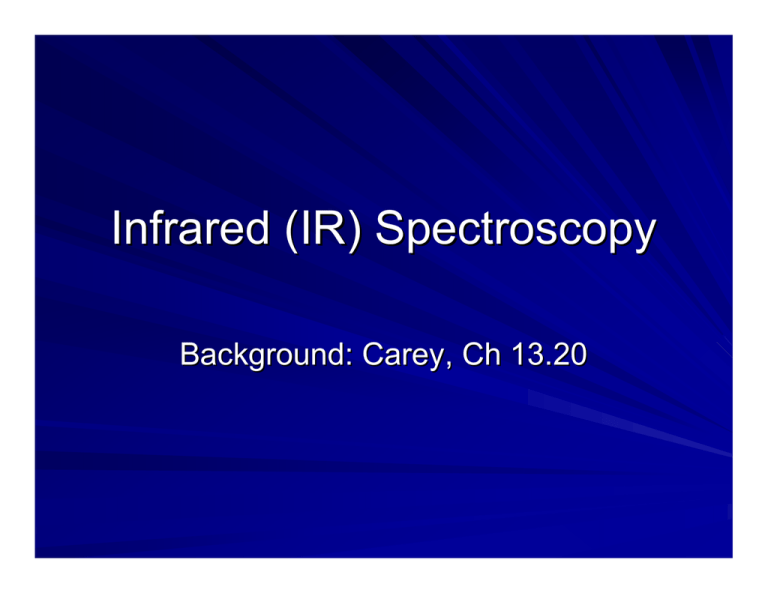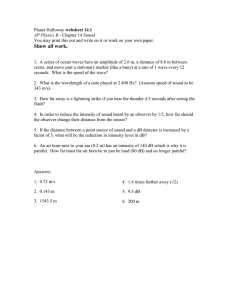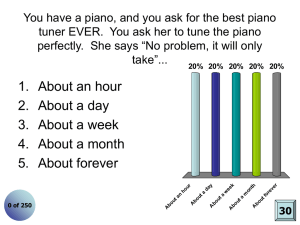
Infrared (IR) Spectroscopy
Background: Carey, Ch 13.20
Electromagnetic Radiation
Radiation is absorbed & emitted in photons. The
defining characteristic of a photon is that its
energy cannot be split into smaller pieces.
Each photon’s energy is defined by its frequency
(ν) or wave length (λ) or wave number (wn)
Ephoton = hν = hc/λ = hc(wn)
Two constants appear in these formulas
h = Planck’s constant, 6.63 x 10-34 J s
c = speed of light, 3.00 x 108 m s-1 (or 3.00 x 1010 cm s-1)
Wave number (wn) = 1/λ
IR Radiation
IR absorbed by organic molecules
– 600-4000 cm-1
– Photon energy = hc(wn) = 1.2-8.0 x 10-20 J
– Molar photon energy = 7.4-49 kJ/mol
= 1.8-12 kcal/mol
IR photon energy <<< covalent bond energy.
Absorbing IR radiation should not trigger
substantial chemical changes. But IR radiation
contains more energy than random thermal
motion at room temperature (~ 0.6 kcal/mol)
IR Spectrum
Plot IR energy vs. %transmittance (%T)
– Energy scale in wave numbers, wn (cm-1)
– %T scale
Compares intensity of IR striking sample (Iin) with intensity of
IR leaving sample (Iout)
100%T no light absorbed by sample
0% all light absorbed by sample
SAMPLE
incident IR (Iin)
transmitted IR
%T = 100 x (Iout / Iin)
(Iout)
IR Spectrum
Record
– Wave number location of IR “band” (position of max
%T)
– Intensity of IR “band”
s = strong (low %T), m = medium, w = weak (high %T)
vs = very strong, vw = very weak
100% T
w
m
m
s
0% T
CH3CH2CH2CH2CHCH3
OH
3500
3000
2500
2000
1500
1000
Wave number, cm-1
Where do you measure the position of the “black” band?
What is its intensity?
Francis A. Carey, Organic Chemistry, Fifth Edition. Copyright © 2003 The McGraw-Hill Companies, Inc. All rights reserved.
500
CH3CH2CH2CH2CHCH3
OH
vs
3500
3000
2500
2000
1500
1000
Wave number, cm-1
Where do you measure the position of the “black” band?
What is its intensity?
Francis A. Carey, Organic Chemistry, Fifth Edition. Copyright © 2003 The McGraw-Hill Companies, Inc. All rights reserved.
500
Energy Trends
Energy follows vibration frequency of atoms
Light atoms vibrate more rapidly
– CH, NH, OH vibrations > 2800 cm-1
Multiple bonds vibrate more rapidly
– Triple bonds
C≡C (2100-2200)
– Double bonds
C=O (1680-1750)
– Single bonds
C–O (1025-1200)
C≡N (2240-2280)
C=C (1620-1680)
Stretching > Bending > Wagging/Twisting
Parsing a Spectrum
C≡C
C≡N
OH, NH, CH
C=C
C=O
CH3CH2CH2CH2CHCH3
OH
3500
3000
2500
2000
1500
1000
Wave number, cm-1
Francis A. Carey, Organic Chemistry, Fifth Edition. Copyright © 2003 The McGraw-Hill Companies, Inc. All rights reserved.
500
Fingerprint Region (<1500 cm-1)
Many bands & many overlaps
– Heavy atom stretches
– All bends, etc.
Should have simple molecule (or other evidence for
structure) before interpreting bands in this region
Overall pattern reflects molecular structure
Pattern from 1400-600 = “molecular fingerprint”
Fingerprint Region
C≡C
C≡N
OH, NH, CH
C=C
C=O
CH3CH2CH2CH2CHCH3
OH
3500
3000
2500
2000
1500
1000
Wave number, cm-1
Francis A. Carey, Organic Chemistry, Fifth Edition. Copyright © 2003 The McGraw-Hill Companies, Inc. All rights reserved.
500
Intensity Trends
Follows change in dipole caused by vibrating
atoms
Polar bonds (strong bond dipoles) absorb strongly
– O–H
– C=O, C≡N
– C –O
Nonpolar bonds absorb weakly
– C≡C, C=C
Follows # overlapping bands
CH bands tend to overlap
Molecules contain many CH
Æ CH absorptions tend to be strong
Complete Workshop
Assignment
Download from Class Web Page
Use Table in Lab Manual
Turn in Completed Assignment



